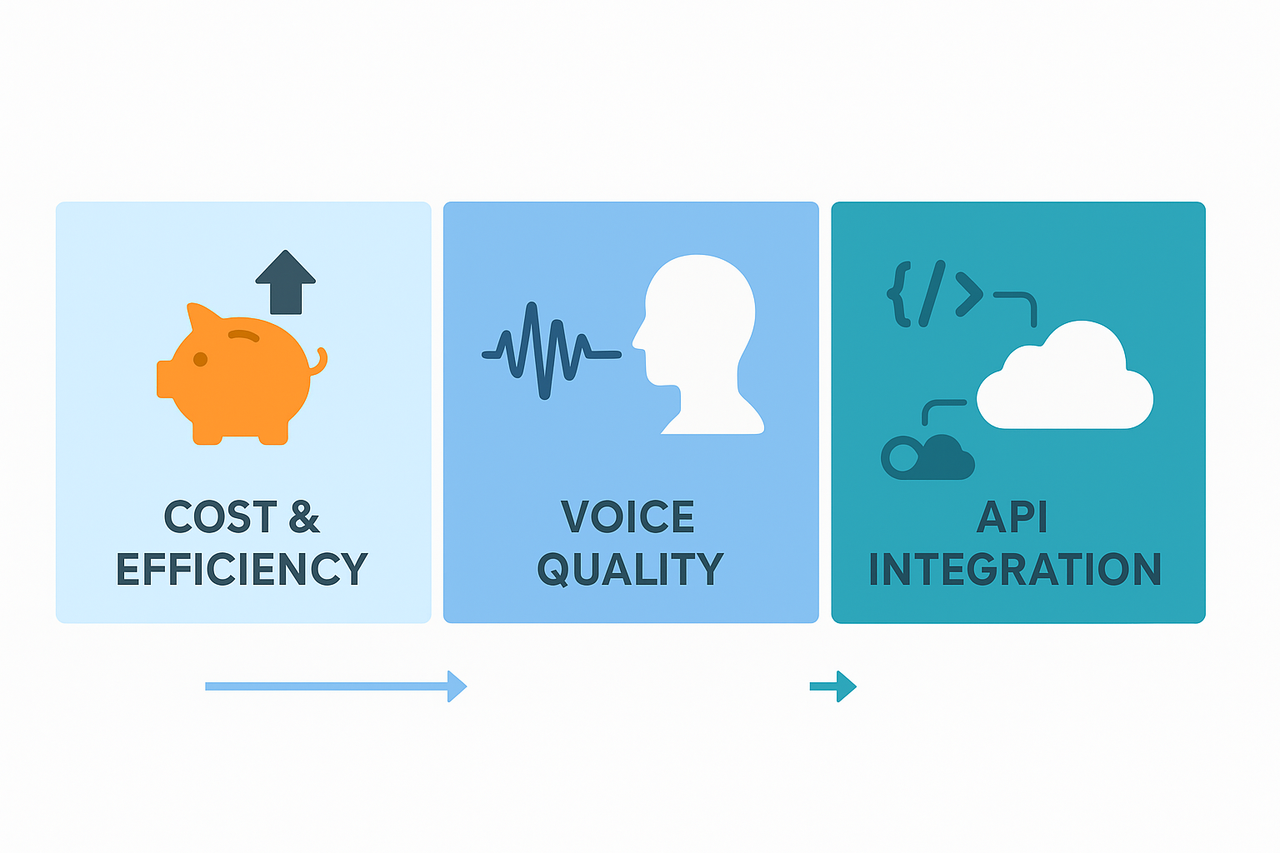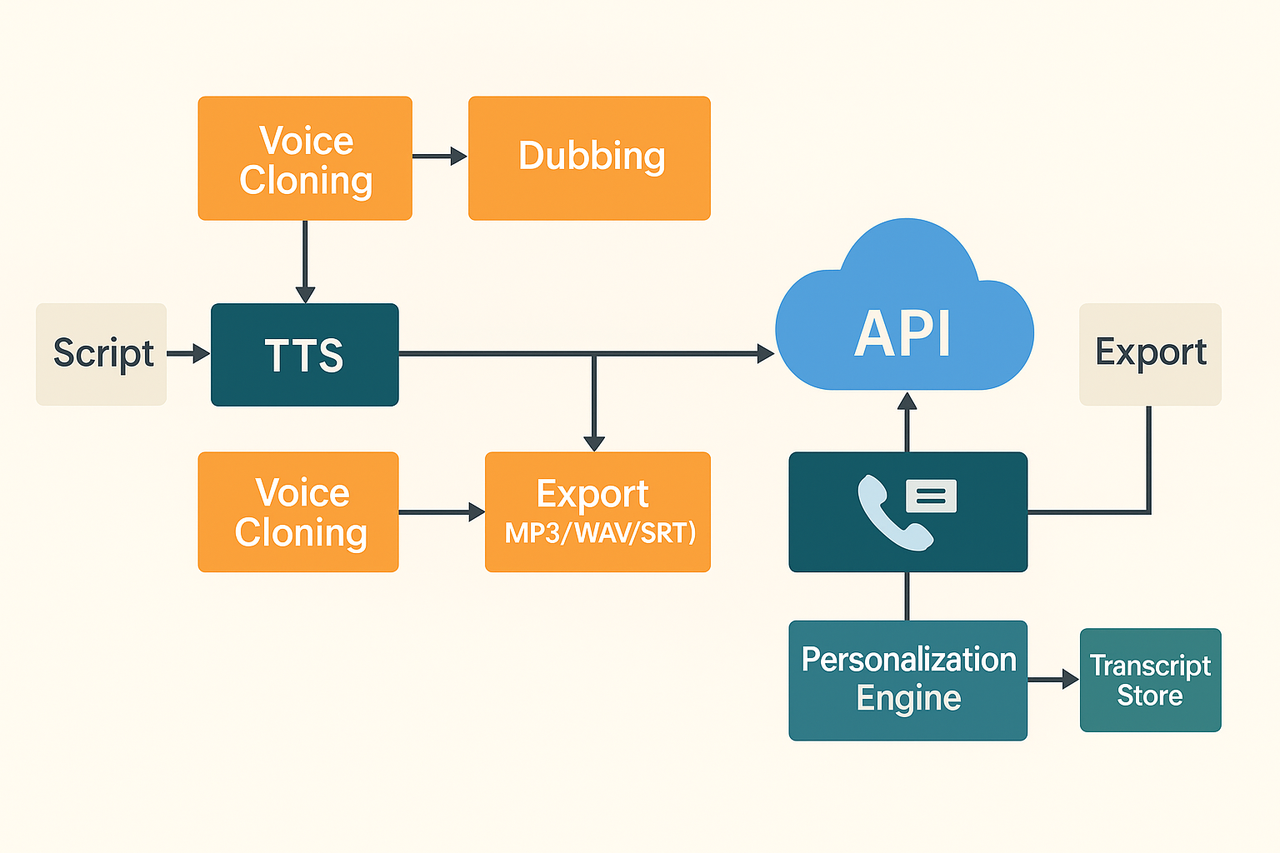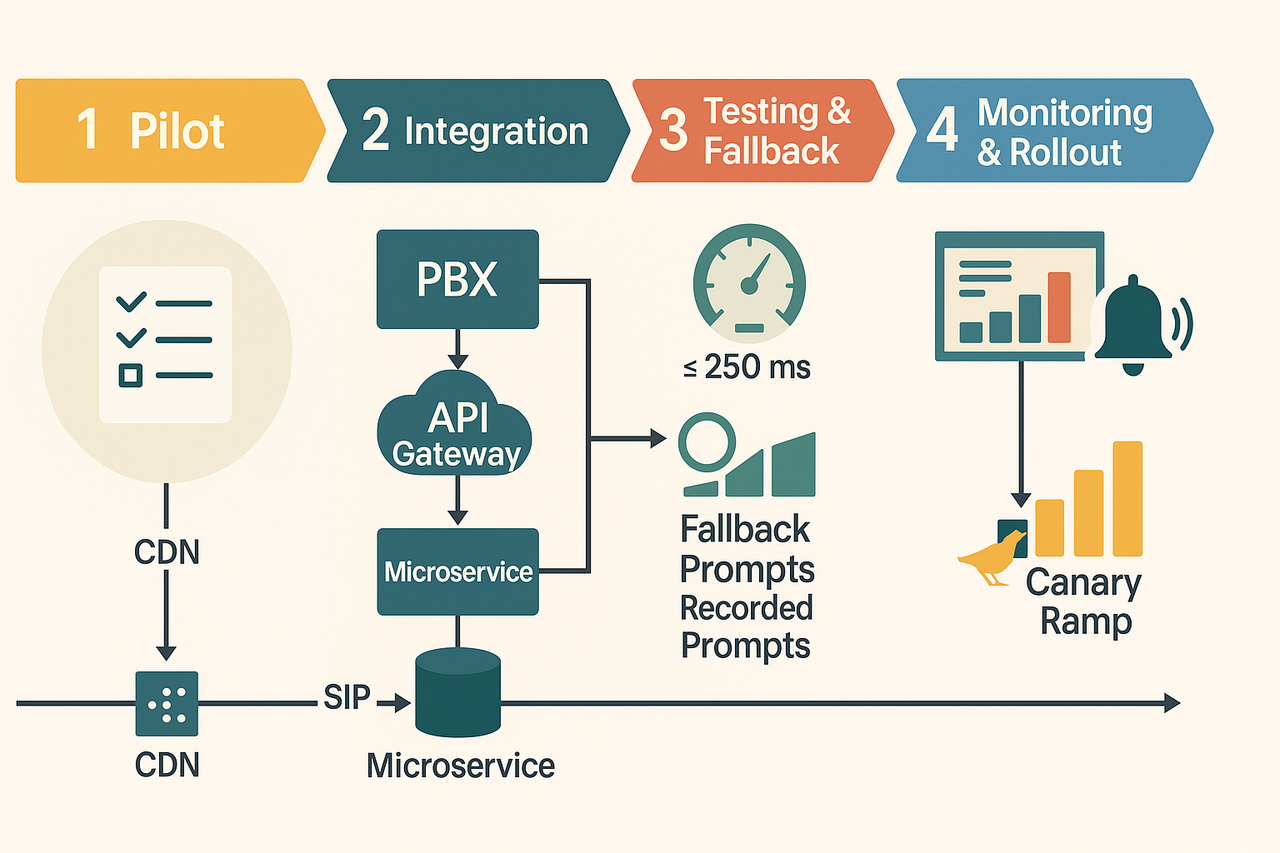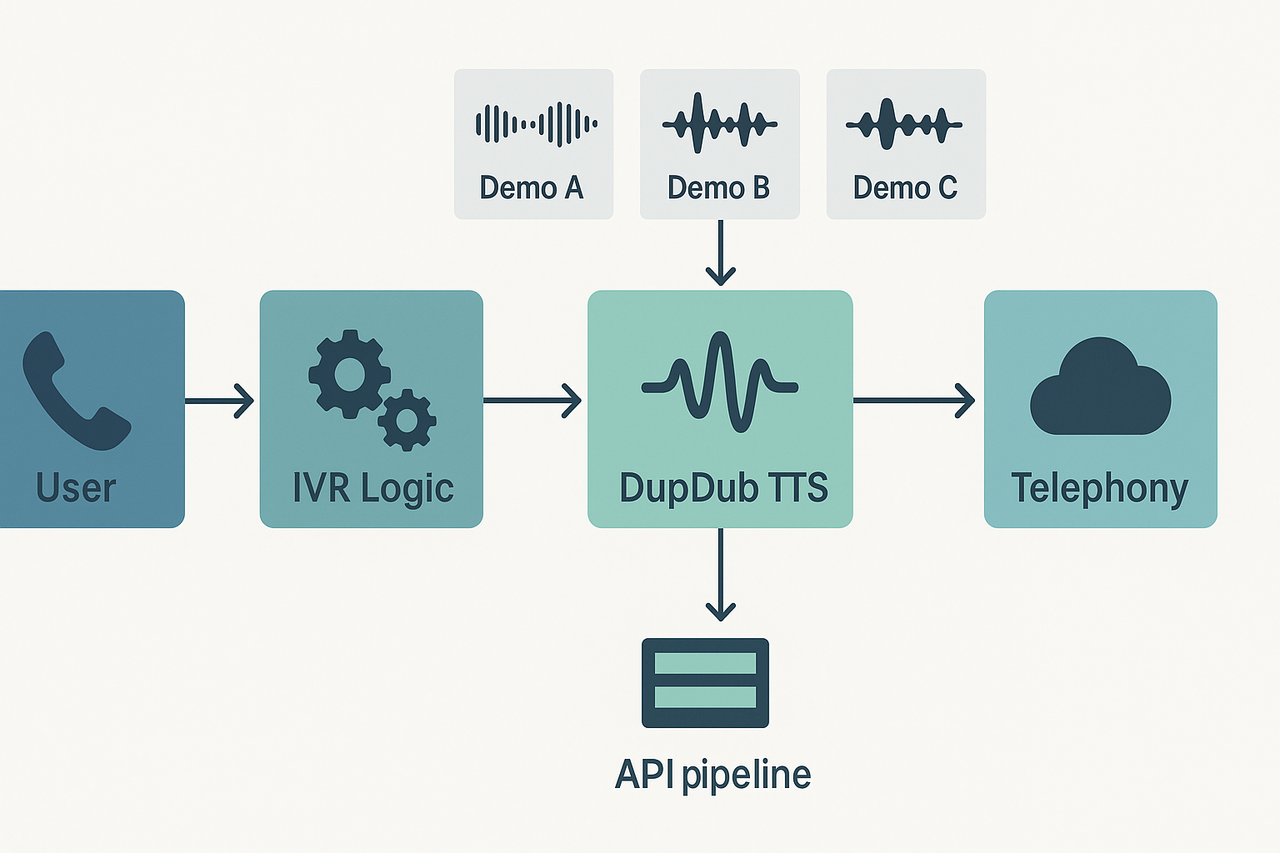TL;DR — What this article covers and the bottom line
This guide explains how IVR TTS and AI IVR voice generators work, when to replace recorded prompts, and how to run a pilot that proves ROI. It covers voice cloning, API integration, latency and compliance checks, implementation steps, a vendor comparison, and a mini case study with audio demos.
Bottom line: switch when you need faster localization, consistent brand voice at scale, or measurable cost and efficiency gains. Expect better containment, faster time to market for new flows, and simpler multilingual support when the chosen solution delivers natural voices, low latency, and robust API controls.
Next steps for evaluators: scope a 4–8 week pilot that tests voice quality, IVR latency, and DTMF/IVR integration. Use side-by-side audio demos, an ROI snapshot, and an implementation checklist to compare vendors and make a data-driven decision. Trial, demo, and ROI tools are common options during evaluation.
What is IVR TTS and how AI voices for IVR evolved
IVR TTS stands for interactive voice response text to speech. It converts text prompts into spoken audio inside phone menus and automated flows. Modern IVR TTS moves beyond robotic readings to human-like speech that improves clarity and reduces perceived wait time.
Compare recorded prompts and neural voices
Recorded prompts use human actors who read fixed scripts. They sound natural, but are expensive to update and scale. Neural AI voices generate speech on demand, so you can change wording, languages, and tones without new studio time.
-
Flexibility: recorded prompts need re-recording, and neural voices update instantly.
-
Consistency: recordings can vary session to session, but AI keeps the tone steady.
-
Cost: recordings have upfront fees and editing; neural TTS has subscription or per-use costs.
-
Compliance: recordings are static and audited once; AI needs version control and testing.
Why neural TTS matters for naturalness, latency, and maintainability
Neural TTS models add prosody and subtle timing cues that sound natural. That reduces misheard prompts and repeat calls, so CX leaders see fewer transfers. Latency is key for IVR, and modern engines stream audio with low delay to keep menus snappy.
Maintainability is a big win: teams can edit script text, test voice styles, and deploy updates in minutes. The platform also supports cloning and multi-language voices for brand consistency across regions. DupDub's TTS and voice cloning tools show how a single workflow can cut production time and keep voice quality steady.
In short, swapping recorded prompts for neural TTS lowers operational friction, speeds iteration, and improves caller experience. Evaluate latency, error handling, and version controls when planning a move to AI voices for IVR.
Why switch to AI TTS for IVR: business benefits and measurable outcomes
AI TTS for IVR (text to speech for interactive voice response) cuts ongoing costs and speeds updates. It makes IVR prompts easier to edit, test, and localize. Deploying high-quality synthetic voices also improves containment, and that means fewer repeat transfers to live agents.
Cut operational cost and boost containment
Moving spoken prompts from recorded audio to AI voices removes studio fees and reduces script update cycles. You can update dozens of prompts in minutes, not days. Better voice quality and natural pacing lift containment by lowering caller frustration. That means more self-service completions and fewer agent handoffs.
KPI impacts you can expect
Here are the concrete metrics to track during a pilot:
-
Average handle time (AHT): expect shorter menu interaction and wrap time. Even a 5 to 10 second cut per call scales quickly.
-
Containment rate: better wording and natural intonation can raise containment by a few percentage points.
-
Transfer rate: fewer transfers to live agents reduce load and shrink queue wait times.
-
CSAT and NPS: clearer prompts and consistent tone improve satisfaction scores.
How to model ROI: a quick example
Use a simple equation to estimate annual savings:
-
Start with annual call volume and percent handled by IVR.
-
Multiply by the average seconds saved per call after voice improvements.
-
Convert seconds saved to agent minutes, then multiply by agent cost per minute.
Example: 1,000,000 calls yearly, 60% IVR handled, 8 seconds saved per IVR call. That equals 1,000,000 * 0.6 * 8 = 4,800,000 seconds, or 80,000 agent minutes. At $$0.50 per agent minute, annual savings near$$40,000. Swap inputs to match your center and get a tailored forecast.
What to measure in a pilot
Run a 4 to 8-week pilot that tracks these items: containment, transfers, AHT, drop rates, CSAT, and error logs. Include A/B tests that compare current recorded prompts to the AI voices. Also measure update velocity, the time from script change to live audio.
DupDub can serve as a testbed to generate voices and run quick iterations, or use your chosen TTS provider for the pilot.
Measure gains in containment and AHT first, then project full-run savings. Small per-call wins add up fast, and clear voice prompts improve the whole customer journey.
How DupDub fits IVR use cases: features that matter
This section maps core modules to real IVR needs, from localization to live personalization. It shows how an all-in-one tool handles voice libraries, cloning, latency, exports, and automation. According to
DupDub API Documentation, DupDub's text-to-speech API offers an extensive library of native voiceovers in over 40 languages, with more than 700 options available.
TTS library and localization
The platform's TTS (text to speech) module covers common IVR tasks. Use it to generate multilingual prompts and fallback languages. It handles accents and styles so menus sound local and consistent. This reduces translation pipeline time and speeds up launch.
Brand voice cloning and consistency
Voice cloning keeps a brand voice across channels, from phone to web. Upload a permitted sample to create a cloned voice. Then reuse that voice in prompts, hold messages, and outbound notifications. Consistent tone builds trust and raises NPS scores.
Low-latency real-time generation via API
The API supports low-latency generation for on-the-fly personalization. Generate caller-specific lines, dynamic offers, or SMS audio links during the call. The API also accepts short text updates, so script edits reach production fast. That reduces release friction and shortens iteration cycles.
Exports, formats, and IVR handoffs
IVR systems need standard audio files and timestamps. The platform exports MP3 and WAV, plus subtitle files for logging and transcripts. Use timestamped SRTs for QA and compliance review. These formats plug into PBX systems, cloud contact centers, and media storage.
Key module-to-problem mapping
-
TTS module: solves multilingual prompts and rapid script changes.
-
Voice cloning: ensures brand-consistent hold music and messages.
-
API: enables live personalization and automated content updates.
-
Export (MP3/WAV/SRT): integrates with PBX, IVR builders, and compliance tools.
This mapping helps teams pick the right modules for pilot and scale. Test text changes, accents, and a cloned voice before broad rollout to lower risk and ensure quality.
Step-by-step implementation guide: from pilot to production
This section gives a clear path from pilot to full IVR deployment. It covers a pre-implementation checklist, integration architecture with PBX or CCaaS, testing and fallback strategies, and rollout monitoring. Expect practical targets for latency, test scripts, and an automated audio pipeline that uses DupDub’s API.
Phase 1: Pilot planning and checklist
Start small, measure fast, and learn. A good pilot reduces risk and builds stakeholder confidence.
-
Define goals and KPIs: latency, completion rate, containment rate, and CSAT.
-
Select 1 to 3 call flows for the pilot, focused on high-volume or repetitive tasks.
-
Prepare sample prompts, slot values, and IVR scripts for each flow.
-
Get legal and privacy signoff for any voice cloning or sample data.
-
Allocate monitoring and rollback resources, and set a pilot timeline of 2 to 6 weeks.
Phase 2: Integration architecture and APIs
Design for low latency and reliable handoff between systems.
-
Use a lightweight service that converts text to audio on demand, or pre-generate clips for fixed prompts.
-
For PBX and CCaaS integration, use SIP for signaling, as defined by
RFC 3261: SIP: Session Initiation Protocol RFC 3261 defines the Session Initiation Protocol (SIP), which is used for initiating, maintaining, and terminating communication sessions that include voice, video, and messaging applications. Place TTS calls behind an API gateway to control rate limits and caching.
-
Architecture pattern: IVR platform -> TTS microservice (API) -> audio CDN/blob store -> media server (SIP/ RTP). Add a caching layer for repeated prompts.
Phase 3: Testing, fallback, and QA
Test early, fail gracefully, and measure often. Use deterministic scripts.
Recommended latency targets:
Sample test scripts to run in the pilot:
-
Cold start: request a new voice clip, time total synthesis and delivery.
-
High concurrency: 100 to 1,000 parallel prompt requests, measure error rates.
-
Network loss: Simulate packet loss and validate media server recovery.
-
Fallback test: verify natural recorded prompts play if TTS fails.
Also run UX checks: listen for pronunciation, prosody, and slot-read clarity.
Phase 4: Rollout, monitoring, and scaling
Use staged rollouts and automated checks to limit user impact.
-
Rollout by percentage or region, monitor KPIs, then increase by schedule.
-
Capture metrics: synthesis latency, API errors, cache hit rate, and call abandon rate.
-
Alert on SLA breaches and automatically switch to recorded prompts when thresholds are hit.
-
For scale, pipeline automated audio generation: feed validated scripts into the API, store generated MP3/WAV in the CDN, then reference the URL from the IVR session.
Boldly validate each step before broad rollout to avoid customer friction.
Case study: See DupDub in an IVR flow
Short brief: A contact center pilot used IVR TTS (text-to-speech) to replace recorded prompts. This mini-case shows before and after outcomes, links to embedded audio demos for side-by-side comparison, sample IVR scripts, and practical tips for reading A/B test results from live demos and proofs of concept.
Mini case: what changed and measurable wins
A regional support center switched a key IVR menu from archived human recordings to a cloud TTS voice. The platform cut prompt update time, since editing a line now takes minutes, not hours. Agents reported fewer call transfers, and callers gave higher clarity ratings in the pilot survey.
What the team tracked:
-
Time to update prompts, now handled in a single UI.
-
Error rate for misrouted calls, monitored daily.
-
Caller clarity and tone preference from short surveys.
Sample IVR scripts and quick variants
-
Welcome (formal): "Welcome to Acme Support. For service, press 1."
-
Welcome (friendly): "Hi, thanks for calling Acme. Press 1 for service."
-
Hold message: "Please hold. We’ll be with you shortly."
Use short lines, consistent punctuation, and explicit transfer cues.
How to interpret A/B test results from demos and POCs
-
Set one primary metric, like reduction in transfers.
-
Compare listening metrics: comprehension, tone preference, and average handle time.
-
Run tests over two weeks to smooth daily variance.
-
Use caller segments to see if preferences differ by language or region.
These steps help you pick the voice and script that lift metrics without extra ops work.
Compare: DupDub vs other AI IVR voice generators
This comparison helps procurement and architecture teams weigh options for IVR TTS. It shows where a unified tool wins, and where niche vendors or on-prem solutions may be better. DupDub is referenced once here to highlight its combined strengths; after that, the text uses neutral terms.
Core capability and workflow
Look for a platform that covers text to speech, voice cloning, and a single workflow for media and subtitles. The platform advantage is fewer handoffs, faster iteration, and simpler testing. If you need voice cloning, confirm language and accent support and verify consent rules for cloned voices.
Feature and performance checklist
Below is a compact comparison of common decision points. Use it as a quick shortlist during vendor screens.
|
Attribute
|
DupDub
|
Specialty TTS vendors
|
Enterprise IVR vendors
|
Open-source / Custom
|
|
Voices & languages
|
700+ voices, 90+ languages
|
Very high-quality single-language models
|
Focused voice sets for telephony
|
Varies, needs engineering
|
|
Voice cloning
|
Yes, consent controls
|
Limited or add-on
|
Rare, often third-party
|
Possible, needs data
|
|
API & real-time
|
Low-latency API
|
API varies
|
Telephony integrations
|
Custom APIs required
|
|
Latency & scale
|
Real-time, scalable
|
May be fast but scoped
|
Carrier-grade SLAs available
|
Depends on infra
|
|
Security & compliance
|
Encryption, data controls
|
Varies by vendor
|
Strong enterprise controls
|
Depends on implementation
|
|
Integration & workflow
|
Multimodal, media-ready
|
TTS only
|
End-to-end IVR platforms
|
Highly customizable
|
|
Pricing model
|
Credit-based tiers
|
Per-second or subscription
|
Enterprise contracts
|
Infrastructure + dev cost
|
Where others lead
Specialist TTS vendors can offer ultra-natural single-language voices and deep prosody control. Enterprise IVR vendors often bring carrier partnerships, guaranteed SLAs, and on-prem options for strict customers. Open-source or custom builds offer full control and no vendor lock-in, but they demand engineering time and cost to maintain. If telephony latency, guaranteed uptime, or an on-prem requirement are critical, prioritize those vendors in your RFP.
How to pick: practical guidance
Define three must-have metrics for a pilot: latency, speech naturalness score, and error rate for dynamic prompts. Run a short live IVR pilot during business hours. Measure handle time, containment rate, and customer satisfaction. Favor a vendor that lets you test with real prompts, provides an API for automation, and shows clear controls for voice consent and data security.
Limitations, common pitfalls, and how to mitigate them
This section lists realistic limits you’ll hit when moving IVR systems to AI. Expect voice mismatch, accent handling challenges, caller interruptions, latency edge cases, and compliance risks. It also gives clear mitigation steps you can apply before full rollout. Mention: IVR TTS once in the first paragraph to anchor search intent.
Fix voice mismatch and the uncanny tone quickly
AI speech can sound odd when the style or pacing is wrong. For AI voices for IVR, small timing or emotion errors cause pushback from callers. Test voice samples with real prompts.
-
Use short pilot scripts that reflect real menu prompts and hold messages.
-
Record side-by-side native voice and TTS demos, then pick the closest match.
-
Add brief human recordings for sensitive nodes like legal or charge notifications.
Handle accents, interruptions, and live caller behavior
Callers speak fast, use slang, or interrupt prompts. TTS must fit natural turn-taking to avoid frustration. Run live stress tests with diverse speakers.
-
Do accent-aware testing across your top caller regions.
-
Build quick skip or repeat options so callers can interrupt safely.
-
Log failed prompts and map them to rule changes in the IVR tree.
Reduce latency and edge-case failures
Latency breaks the flow when prompts lag or overlap. Plan for regional edge nodes and graceful fallbacks.
-
Profile end-to-end latency during peak and off hours.
-
Implement local caching of common prompts in telephony gateways.
-
Create fallback prompts: short, neutral prerecorded audio if generation fails.
Plan for data residency, consent, and audits
Legal and security teams must own voice data, consent, and residency controls.
What rules apply if my organisation transfers data outside the EU? states: The GDPR provides different tools to frame data transfers from the EU to a third country, including adequacy decisions and standard contractual clauses. Map where audio and transcripts live, encrypt in transit and at rest, and prepare an audit checklist for compliance teams.
Key next steps checklist
-
Run a 4-week pilot with scripted prompts and live callers.
-
Deliver a latency and failover report to the platform and network teams.
-
Produce a data-residency plan and consent workflow for legal review.
Best practices: Designing IVR scripts and optimizing AI voices
Keep prompts short and task-focused, and aim for clarity. Good IVR TTS starts with simple, direct lines that guide callers fast. Use plain language and one action per prompt, for example: "Press 1 for billing, 2 for support." Mention: DupDub once when referring to a platform option, then switch to neutral language.
Write short, task-focused prompts
-
Use 5 to 12 words per prompt. Short prompts reduce caller effort.
-
Lead with the action, then the reason, for example: "Report a lost card, to protect your account."
-
Use SSML (Speech Synthesis Markup Language) to control pauses, emphasis, and pacing.
Use progressive disclosure to reduce choices
Start broad, then narrow options after a selection. Present 2–4 choices first, then ask follow-ups. This lowers abandonment and speeds navigation.
Create a consistent voice persona
Define a persona: tone, formality, and vocabulary. Keep it consistent across menu prompts, hold music, and callback messages. Match persona to brand and caller need, for example calm and precise for finance.
Personalize without friction
Insert safe dynamic fields like name, last four digits, or timezone. Keep privacy in mind, and avoid repeating sensitive data. Use short confirmations to reduce errors.
Measure and iterate: monitoring and A/B testing
Use simple KPIs to judge voice and script changes:
-
Containment rate (self-service success)
-
Average handle time or time-to-resolution
-
Abandonment after prompt
-
Customer satisfaction (CSAT) on post-call surveys
Run this A/B test framework:
-
Pick one variable: wording, pause length, or voice style.
-
Split traffic evenly and run for a set period.
-
Compare containment, AHT, and CSAT.
-
Roll out the winner, then test the next change.
Monitor logs and listen to samples weekly. Iterate in small steps, and document every test. Small, frequent changes beat big, rare rewrites.
FAQ — Quick answers to common questions
-
How fast is voice cloning for IVR TTS?
Most teams see a usable clone in minutes after uploading a short sample. The process is fast enough for pilots, and the platform can generate the final speech in real time. DupDub supports instant cloning so you can iterate on scripts quickly.
-
Which languages and accents does an AI IVR voice generator support?
The tool covers 90-plus languages and many regional accents for TTS, with voice cloning available in dozens of languages. You’ll also find hundreds of voice styles, which help match tone for diverse caller bases.
-
How is voice data secured for ai voices in IVR?
Voice uploads and generated audio are encrypted in transit and at rest. Only the original speaker may request cloning, and data is not used for third-party model training. Follow internal consent rules before cloning agent voices.
-
What latency can I expect for live IVR and real-time TTS?
Expect low latency, often sub-second for simple prompts, depending on network and integration. For streaming or complex dialogues, test under real call load to measure end-to-end latency.
-
Can I use cloned agent voices in compliance-sensitive IVR flows?
Yes, with safeguards: record explicit consent, keep audit logs, and restrict who can export or reuse a clone. Add a consent script to your IVR and map cloning access to a secure role.
-
How do teams test proof of concept using the API and ROI calculator?
Start small: pick 5 common prompts, run a short pilot, measure handle time and containment. Use the API to automate prompts and capture metrics, then plug results into an ROI snapshot to estimate savings. Share pilot audio and metrics with stakeholders for fast buy-in.





